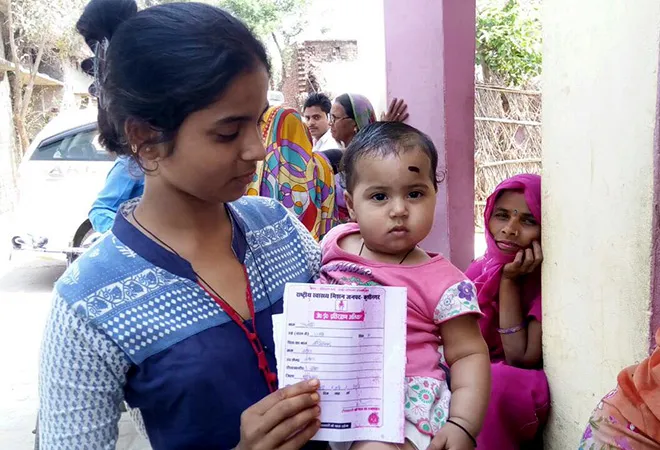
Uttar Pradesh has been reporting outbreaks of encephalitis since 1978. In the 1980s and 90s , around 1,000 cases were reported annually with a case fatality rate of 20-30%. Major outbreaks occurred in 1978, 1988 and again in 2005 where case numbers and corresponding fatalities were significantly higher. After the 2005 outbreak, the following years reported a tripling of the caseload with an average of 3,000 cases and 5-600 deaths per year. In recent years, the number of fatalities had been creeping higher with 4 of the 5 years from 2013-17 reporting over 600 fatalities.
Originally it was believed that all cases were caused by the Japanese Encephalitis virus, a mosquito-borne disease, but subsequent testing has shown that only about
13% of cases test positive for JE. As a result, cases were classified under the umbrella term ‘Acute Encephalitis Syndrome.’ Uttar Pradesh has hosted many research teams over the years that have attempted to ascertain the pathogen behind the AES outbreaks. It was suggested that poor quality drinking water obtained from shallow wells might be a problem. Testing has shown a high positivity for various enteroviruses like EV-76, EV-89,
coxsackievirus B5 and echovirus 19. Furthermore, a
study by the US CDC for the 2011-12 season concluded:
“The current AES/JE surveillance system has a complicated specimen referral and reporting system at the district level, and the available line lists suggest that data are of low quality. Without evidence to estimate the effect of interventions, AES prevention and control measures may be ineffective and public health resources may be wasted.”
An epidemiological
study carried out in Saharanpur in the early 2000s found that children were eating beans of the
Cassia occidentalis plant which was causing acute hepatomyoencephalopathy. These patients were being misdiagnosed as AES cases. Local government organized a removal of these plants and provided information programs for residents. As a result, fatalities in the district dropped from around 100 per year to
zero in 2010. In recent years, tick-borne
Scrub Typhus has emerged as a likely player with as many as
two-thirds of all AES cases testing positive. This has led to a a new set of
prevention and treatment recommendations. It is likely that a combination of all of these factors, coupled with poverty, malnutrition and lack of available healthcare has led to repeated high mortality outbreaks in UP. Since the problem is complex, the solution is equally challenging.
Yogi Adityanath served as a member of
Parliament representing Gorakhpur from 1998 until 2017, when he became Chief Minister of Uttar Pradesh. Baba Raghav Das Medical College and Hospital in Gorakhpur was the last port of call for many seriously ill AES patients. Often, patients arrived too late and the overstretched and underfunded facility could do little to save lives. In August of 2017, due to an unpaid
bill, the oxygen supply was interrupted, and several dozen patients died. Further, national spotlight revealed many of BRD’s shortcomings. Once O
2 was restored, national media could not understand why the death toll kept rising. It only gradually
dawned that a dozen deaths a day was normal for this hospital.
Adityanath responded with a comprehensive
plan. Scrub Typhus treatments began to be implemented in September of 2017. A massive JE vaccination plan covered 8.8 million children in 2018. Increased funding to Primary Health Centers led to better facilities that were cope with locally and rapidly with AES cases in better ways. A widespread public information campaign ( Dastak) was held in July 2019 going door-to-door to inform people about communicable disease avoidance and treatment. Every one of these efforts is laudable and coupled with major water infrastructure improvement in the state, should result in reduced case and fatality numbers. On the face of it, the numbers being reported for AES in 2018 and 2019 indicate success (Table 1). In a recent speech, Adityanath cited a 65%
reduction in AES fatalities and promised that the scourge may be eliminated in two to three years. A recent in-depth
report suggests that the number of patients this year is reduced; it also suggests that more patients are being treated locally, leading to better outcomes.
|
Gorakhpur District
|
All of Uttar Pradesh
|
|
2017 |
2018 |
2019* |
2017 |
2018 |
2019* |
| Cases |
3,692 |
1,660 |
389 |
4,724 |
3,018 |
890 |
| % of state cases that occurred in Gorakhpur facilities |
78% |
55% |
44% |
— |
— |
— |
| Fatalities |
556 |
186 |
35 |
654 |
230 |
35 |
| % of state fatalities that occurred in Gorakhpur facilities |
85% |
81% |
100% |
— |
— |
— |
| Case Fatality Rate |
15.1% |
11.2% |
9.0% |
13.8% |
7.6% |
3.4% |
| % of cases tested positive for Japanese Encephalitis |
9.91% |
N/A |
8.7% |
14.7% |
10.5% |
6.2% |
Table 1. Trends in recent cases of AES in Uttar Pradesh.
*till August
While I am hopeful, there are aspects of the situation in UP that make me worried that AES success is being used as a political football. In previous years, the BRD hospital released daily case and fatality figures that were published by organizations like Jagran.com weekly. These stopped in late
September 2017. Media resorted to unofficial hospital
sources which, through June, tracked AES deaths in 2018 as being
higher than 2017. Up until June, official figures showed an enormous
increase in cases statewide, but then began to behave oddly.
Multiple outlets
reported 80+ deaths at BRD through July, but by 31 August, this number was being reported as 63 with only six deaths occurring in August. Reporters found that patients from out of state were no longer being
included in official figures leading to numbers that could be artificially low — up to 35%
lower than previous years. Official
figures reduced the total number of deaths reported statewide from 118 on 31 July to 113 by 31 August. Reports emerged of widespread disease data manipulation, for
example in Bareilly where, of 202 fever deaths, only 28 were recorded by the district. In my own analysis of NVBDCP monthly reports, I noted the following: From Jan to 29 June, 112 fatalities from 1,171 cases (9.6%) were reported, 11 fatalities from 1,517 cases (0.73%) were tallied from July to October, then 107 deaths from 392 cases (27.3%) from October to the end of the year. It seems to me that there is some manipulation of these figures.
One doctor was
detained for examining patients classified as “fever” and declaring them to be AES cases. Other
reports suggest that doctors were ordered not to report AES cases, but to classify them as something else. An opposition party organized a
walkout from the State Assembly in protest. An
allegation was made that BRD personnel suspected of talking to the press were transferred. News reports continued to find higher numbers of deaths than were being officially reported.
In 2019, AES figures remain tightly
controlled. At FluTrackers.com we monitor local media. In
2017, we found over 150 distinct local media articles publishing information on AES cases in UP,
this year we have found 16 to date. The appearance of a lack of transparency leaves many questions. While the state is reporting 890 AES cases till August, the NHM is reporting 5,498 Japanese Encephalitis tests performed up till 24 August.This raises an important question: If such a large number of patients is suspected of having JE, why are they not being counted as AES patients? Are Scrub Typhus cases being included in the AES figures this year? If not, then that would reduce the numbers significantly. Are out of state patients included? What is the mechanism of reporting from the local PHCs? How many of the cases had been vaccinated? Where are the patients being treated? How are they being treated? What are the outcomes regarding mental and physical disability in survivors? Will current treatment methods be evaluated scientifically and result in publication? If access to the data is not open and freely available, it will always be questioned. Let doctors speak, allow journalists to question, and encourage scientists to investigate. Learn from failures and promote successes, but above all — be open and honest.
The views expressed above belong to the author(s). ORF research and analyses now available on Telegram! Click here to access our curated content — blogs, longforms and interviews.




 PREV
PREV


